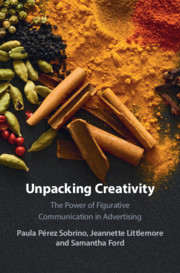Book contents
- Unpacking Creativity
- Unpacking Creativity
- Copyright page
- Dedication
- Contents
- Figures
- Tables
- Acknowledgements
- Introduction
- Part I Theoretical Perspectives
- 1 The Temple of Heaven Is Not China
- 2 Is It a Bird or Is It a Chameleon?
- 3 Welcome to the Black Supermarket
- 4 I Thought They Were Hairy Breasts!
- Part II Empirical Studies
- Notes
- Appendix
- References
- Secondary References
- Index
2 - Is It a Bird or Is It a Chameleon?
How Do Advertisers Maximise the Potential of Metaphor in Advertising Through Visual Creativity?
from Part I - Theoretical Perspectives
Published online by Cambridge University Press: 14 August 2021
- Unpacking Creativity
- Unpacking Creativity
- Copyright page
- Dedication
- Contents
- Figures
- Tables
- Acknowledgements
- Introduction
- Part I Theoretical Perspectives
- 1 The Temple of Heaven Is Not China
- 2 Is It a Bird or Is It a Chameleon?
- 3 Welcome to the Black Supermarket
- 4 I Thought They Were Hairy Breasts!
- Part II Empirical Studies
- Notes
- Appendix
- References
- Secondary References
- Index
Summary
Chapter 2 considers aspects of visual design and explores the advantages and disadvantages of different forms of layout. It discusses the ways in which advertisers make use of visual resources to represent metaphors and metonymies. It shows how the same metaphor can be represented in multiple different ways leading to different processing or pragmatic effects. The chapter shows how two key dimensions of creativity (meaning and form) work together in the production and reception of figurative meaning in the context of advertising. It first reviews the ways in which scholars have operationalised ‘visual complexity’ as an experimental variable, and reports findings from the few studies that have attempted to measure its impact. It then proposes a new distinction based on the degree of schematicity versus content richness of the metaphorical/metonymic image. Schematic images contain very few visual elements to help the consumer interpret the message, whilst content-rich images contain numerous details on which the consumer can draw. In the final section, the chapter introduces another tool that advertisers can exploit in order to maximise the impact of visual creativity: that of colour.
Keywords
- Type
- Chapter
- Information
- Unpacking CreativityThe Power of Figurative Communication in Advertising, pp. 36 - 57Publisher: Cambridge University PressPrint publication year: 2021

